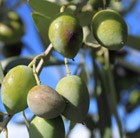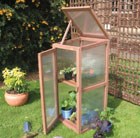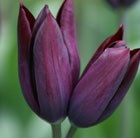New products at Crocus
by Sarah - November 21st, 2009.Filed under: Crocus, New Products.
New products at Crocus

olive tree £34.99
Position: full sunSoil: deep, fertile, sharply drained soil (or loam-based potting compost for container-grown specimens)Rate of growth: slow-growing Flowering period: June to August Flower colour: creamy-whiteOther features: in hot summers the flowers are followed by edible, spherical, green fruitsHardiness: frost hardy (needs winter protection)Tiny, fragrant, creamy-white, summer flowers and grey-green leaves, retained all year. This elegant, evergreen tree makes an excellent specimen plant for a sunny, Mediterranean-style garden. In frost-prone areas it’s best grown in a large container under glass or planted at the base of a sunny, sheltered wall.Garden care: To protect against wind damage stake using a low angled stake, driven into the ground on the windward side at a 45° angle. Water regularly during dry periods, keeping the planting area weed-free. Apply a top-dressing of a nitrogen-rich general purpose fertiliser twice or three times each year during the growing season.

wooden-mini-growhouse £34.99
Raise your seedlings and harden them off in this fabulous fsc pine framed, space-saving mini greenhouse. It has a full sized door for easy access and an opening sloping lid for ventilation control, all made from twin-walled, polycarbonate. There is a back to the greenhouse so it can be free-standing and doesn’t have to lean against a wall. Also the shelf can be removed so you can put tall plants inside to overwinter.Size: 82 high x 36 width x 36cm depth

rose campion £7.99
Position: full sun or partial shadeSoil: fertile, moist, well-drained soilRate of growth: averageFlowering period: July to AugustFlower colour: pinkOther features: downy, silver grey leavesHardiness: fully hardyWonderful, disc-shaped, pink flowers seem to float on slender, branching stems above downy, silver grey leaves. This charming, summer flowering campion looks great towards the middle of a sunny, mixed border. It thrives in dry soils in full sun and although short lived perpetuates itself by self seeding freely. Garden care: Apply a generous 5-7cm (2-3in) mulch of well-rotted compost around the base of the plant in early-spring. Cut back the faded flowerheads in late autumn.As these plants are short lived perennials or bi-ennial they usually only live for a couple of years, however they do self-seed freely.

rose campion £6.99
Position: full sun or partial shadeSoil: fertile, moist, well-drained soilRate of growth: averageFlowering period: July to AugustFlower colour: magenta pink flushd with whiteHardiness: fully hardyDazzling, disc shaped, magenta pink flowers which fade to white at the centre and have pinkish-purple veining, appear on slender, branching stems in late summer above clumps of downy, silver grey leaves. Rose campion is an ideal plant for the middle of a sunny, well drained border. Best in dry soil and full sun the spent blooms should be dead-headed regularly to prolong flowering.Garden care: Apply a generous 5-7cm (2-3in) mulch of well-rotted compost around the base of the plant in early-spring. Cut back the faded flowerheads in late autumn after they have released their seed.It is worth keeping in mind that these plants are short lived perennials or bi-ennial, so although they usually self-seed freely, the plant will only live for a couple of years.

lungwort £5.99
Position: partial shadeSoil: humus-rich, moist, well-drained soilRate of growth: averageFlowering period: March to MayFlower colour: rich blueOther features: dark green leavesHardiness: fully hardyThis piercing blue cowslip bears clusters of rich-blue, funnel-shaped flowers from early to late spring and mid- to dark green leaves. Named after the woodland garden at Munstead Wood created by Edwardian plantswoman Gertrude Jeykll, it is a particularly lovely groundcover plant for moist, shady areas. Garden care: Lift and divide large clumps every three to five years after flowering or in autumn. Cut back plants affected by mildew to the ground, water and feed – the plant will regenerate and produce new leaves later in the year.

triumph tulip £1.74
Position: full sunSoil: fertile, well-drained soilRate of growth: averageFlowering period: AprilFlower colour: deep blackcurrantOther features: excellent cut-flowersHardiness: fully hardyBulb Size: 12/14Deep blackcurrant coloured blooms with up to 3 flowers per stem appear in April. This has a similar colouring to the very popular Queen of Night tulip, but the flowers appear earlier on this variety. Therefore it is a great combination if you are looking to have an extended period of rich, deep colour in spring.Garden care: In September to December plant bulbs 15-20cm deep and 10-15cm apart in fertile, well-drained soil. Alternatively, allow 7-9 bulbs per 30cm sq. After flowering dead-head and apply a balanced liquid fertiliser each week for the first month. Once the foliage has died down naturally lift the bulbs and store in a cool greenhouse.

crocus £1.49
Position: full sunSoil: gritty, poor to moderately fertile, well-drained soilRate of growth: averageFlowering period: February and March Flower colour:pale lilac-blue Other features: slender, strap-shaped, grey-green leavesHardiness: fully hardyBulb Size: 5/7Yellow-throated, white flowers with soft, silvery, lilac-blue outer petals in February and March. The flowers are framed by slender, strap-shaped, grey-green leaves. These spring-flowering bulbs are versatile and easy-to-grow. They are suitable for naturalising in grass or planting in sunny areas of a rock garden or shrub border. They need well-drained soils and prefer dry summers.Garden care: Plant bulbs in tight clusters to form naturalistic drifts 10cm deep where they can be left undisturbed for several years. Keep a look out for mice or squirrel damage. This can sometimes be avoided by laying a piece of chicken wire over the bulbs before you cover them with soil. If you are growing these in grass, avoid mowing it until the leaves have completely died back.






